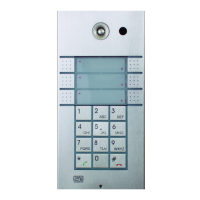
Do you have a question about the 2N Helios and is the answer not in the manual?
| SIP Protocol Support | Yes |
|---|---|
| Type | IP Intercom |
| Camera | Yes |
| Connectivity | Ethernet |
| Power Supply | PoE (Power over Ethernet) |
| Material | Metal, Plastic |
| Protection | IP54 |
| Display | Touchscreen |
| Keypad | Yes |
| RFID Reader | Optional |
| Outputs | Relay outputs |
| Communication | SIP |
| Call Handling | Call forwarding |
Details the 2N Helios door communicator, its connectivity, and basic operation.
Lists key features of the 2N Helios communicator, including design, water resistance, and modularity.
Highlights the benefits of using the 2N Helios, such as flat design, hermetic sealing, and electronic controls.
Documents firmware version updates and the specific changes introduced in each version.
Lists and describes various basic units, extender units, and associated accessories for the 2N Helios.
Details the various basic and extender units available for the 2N Helios system.
Describes various mounting boxes and roofs for indoor and outdoor installations.
Covers vandal-resistant masks and wall mounting boxes for enhanced durability.
Lists accessories for GSM and VoIP connectivity, such as gateways.
Details available camera units and video servers for enhanced functionality.
Presents different models of electric locks compatible with the 2N Helios system.
Lists various card reader modules for access control integration.
Includes additional accessories like switches, adapters, transformers, and name plates.
Defines key terms and explains symbols used throughout the manual for clarity.
Defines key terms used in the manual, such as DTMF, PSTN, and code lock.
Explains the meaning of various symbols like Safety, Warning, Caution, Tip, and Note.
Explains the numbering scheme for buttons on whole-button and keypad sets.
Covers the initial steps before installation, including product completeness check.
Details various installation types like indoor/outdoor, surface/flush, and vandal resistant mounting.
Covers compatibility, telephone line connection, PCB layout, and wiring details.
Provides instructions for installing the optional camera unit into the Helios basic unit.
Explains how to connect extending modules in a chain pattern and the maximum count.
Guides on how to insert and replace button labels on the device.
Details final steps for mounting, sealing, and common mounting errors.
Explains how to enter programming mode and the procedure for setting parameters remotely.
A detailed chart listing all programmable parameters, their ranges, defaults, and notes.
Describes the product's functions from both external (visitor) and internal user perspectives.
Covers advanced features like automatic multiple number dialling and DTMF control.
Provides instructions for cleaning the device and handling label replacement.
Lists detailed telephone parameters, including line requirements, impedance, and detector sensitivities.
Details other technical specifications like switch voltage/current, backlight, temperature range, and weight.
Lists directives, laws, and regulations that the 2N Helios product conforms to.
Offers tips for troubleshooting and directs users to an online FAQ.
Provides important general instructions, warnings, and cautions for product usage and installation.
Explains proper disposal procedures for electric waste and used battery packs.